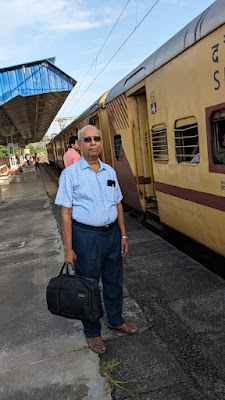Photos: Kiran Nagarkar: Photo by Tulsi Vatsal; Book cover; Author Salil Tripathi. Photo by Udayan Tripathi
In ‘Asides, Tirades, Meditations’ — Selected Essays, Kiran Nagarkar, one of the notable writers of post-Independence India, writes with an electric style on a host of topics
By Shevlin Sebastian
Author Salil Tripathi grew up in an apartment near Kemp’s Corner where Chaitra, an advertising agency, had an office. His mother would translate Chaitra’s advertising copy into Gujarati. Now and then his mother would meet the celebrated author Kiran Nagarkar, who also worked there. When Tripathi was in his twenties, he was introduced to Nagarkar. They began a lifelong friendship.
After his studies abroad, Tripathi joined the Indian Post newspaper as an assistant editor. He offered Nagarkar an opportunity to write a column. The celebrated author became a film critic for foreign films. That is probably how Nagarkar became a columnist for an English-language newspaper.
Tripathi recounted this in his introduction to the book, ‘Asides, Tirades, Meditations—Selected Essays’ by Nagarkar (Bloomsbury).
Tripathi did mention that in 2018, three women journalists accused Nagarkar of behaving inappropriately. He denied the allegations. The next year, Nagarkar died of a cerebral haemorrhage. He was 77.
Tripathi said, “I admired him as a gifted writer, a champion of freedoms, a friend who saw through the clouds clearly, who warned us about the seductive peril of majoritarianism.”
There are 36 essays in the 317-page book, clubbed under the headings, ‘Writing’, ‘Cinema’ and ‘On Society and Politics’.
In the first essay, ‘Clueless: An Occasional Writer’s Journey,’ Nagarkar states, ‘You can dictate to your characters. You can bind them hand and foot, you can take almost all decisions for them, you can make sure that they grow up the way you want them to, but the chances are that you will find in the end that they are not flesh-and-blood people but puppets and marionettes.’
This is probably the drawback of too many writers. But how to make characters come alive seems to be a gift from the Gods. Not everybody can do it.
Nagarkar also confirms the important role played by the subconscious in creative work. ‘While there is no gainsaying the primary contribution of conscious thought and planning, it is the subconscious processes of the mind and that strange chemical laboratory called “gestation” whereby at times things seem to fall into place by themselves and trickier problems get resolved.’
It was interesting to note that Nagarkar studied Marathi for the first four years of his primary education. After that, his parents enrolled him in an English-medium school. Yet, he emerged as a major English writer.
Nagarkar gained fame for his novels, including ‘Saat Sakkam Trechalis’ (tr. Seven Sixes Are Forty Three) (1974), ‘Ravan and Eddie’ (1994), and ‘Cuckold’ (1997).
For ‘Cuckold’, he won the 2001 Sahitya Akademi Award in 2001. His books were very popular in Germany. In 2012, he received the Order of Merit from Germany. Nagarkar was also a dramatist and screenwriter.
Perception abounds in his essays. In an essay regarding libraries, Nagarkar writes, ‘The most extensive and underrated library in the world, especially in the poorer countries, however, is the institution of the grandmother…she is the mother of all libraries, the largest archive of the oral tradition. In India, she is the repository of the stories from the epics, from the Panchatantra and mythology. She is the one who transmits oral history from generation to generation and is the fount of traditional wisdom.’
And he also recalled interesting encounters and conversations. Once he met a friend’s Japanese fiancée. She told Nagarkar, “I know nothing about India, except the four things that I learnt at school.”
“And what are they?” asked Nagarkar.
The woman said, “You Indians eat with your right hand, wash your hind parts with your left. You burn your women and practise untouchability.”
‘A brief, succinct and aphoristic, cultural, political and sociological history of India. A body blow,’ wrote Nagarkar.
In the essay, ‘Shiva’s Blue Throat: A Persona; Vision of the Artist’s Role’, Nagarkar compared the writing style of Nobel Laureate Gabriel Garcia Marquez with Booker Prize winner Salman Rushdie.
‘Rushdie’s joie de vivre, exuberance and deliberate punning are irrepressible,’ wrote Nagarkar. ‘His language is brilliant, flamboyant and endlessly playful ... He is a virtuoso trapeze artist whose words are always flying and caught in mid-air, doing the most incredible twists and turns. How can anyone fail to be carried away by his masterful performance? But neither can we forget that it is a performance.’
As for Marquez, Nagarkar said the language doesn’t bring attention to itself. ‘What strikes you from the very start is the richness and fecundity of his imagery, the almost infinite variety of the stories within stories he has to tell. And yet what you remember most are his characters and their fate.’
Other subjects include memories of his childhood, ageing, pretentious art films, star power in Bollywood, the city of Bombay, climate change, and ‘the fine art of intolerance.’
The book concludes with an afterword by prize-winning novelist Nayantara Sahgal. They met in 2104 and immediately became fast friends.
Nagarkar’s style is direct, clear and straightforward. These are easy-to-read essays. He always has an original viewpoint. There are many insights that are sprinkled all across the essays. Insights that make you pause and reflect and finally, get enriched by.
‘Asides, Tirades, Meditations’ is an engaging read. However, there is no mention of when and where these essays were published. Overall, this is a book worth buying. If you are a serious reader, you will not be disappointed.
(Published in Scroll.com)











